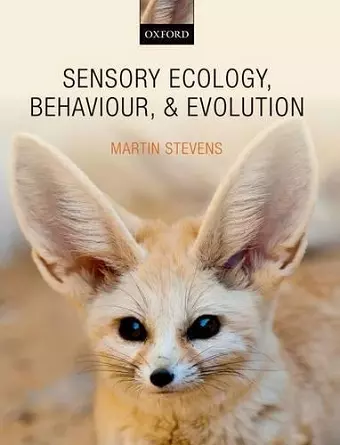Sensory Ecology, Behaviour, and Evolution
Format:Hardback
Publisher:Oxford University Press
Published:7th Feb '13
Currently unavailable, and unfortunately no date known when it will be back
This hardback is available in another edition too:
- Paperback£69.00(9780199601783)

Throughout their lives animals must complete many tasks, including finding food, avoiding predators, attracting mates, and navigating through a complex and dynamic environment. Consequently, they have evolved a staggering array of sensory organs that are fundamental to survival and reproduction and shape much of their evolution and behaviour. Sensory ecology deals with how animals acquire, process, and use information in their lives, and the sensory systems involved. It investigates the type of information that is gathered by animals, how it is used in a range of behaviours, and the evolution of such traits. It deals with both mechanistic questions (e.g. how sensory receptors capture information from the environment, and how the physical attributes of the environment affect information transmission) and functional questions (e.g. the adaptive significance of the information used by the animal to make a decision). Recent research has dealt more explicitly with how sensory systems are involved with and even drive evolutionary change, including the formation of new species. Sensory Ecology, Behaviour, and Evolution provides a broad introduction to sensory ecology across a wide range of taxonomic groups, covering all the various sensory modalities (e.g. sound, visual, chemical, magnetic, and electric) relating to diverse areas spanning anti-predator strategies, foraging, mate choice, navigation and more, with the aim being to illustrate key principles and differences. This accessible textbook is suitable for senior undergraduates, graduate students, and professional academics taking courses or conducting research in sensory ecology/biology, neuroethology, behavioural and evolutionary ecology, communication, and signalling. It will also be of relevance and use to psychologists interested in sensory information and behaviour.
This book is an ambitious and successful attempt to integrate mechanistic and functional aspects of communication by the authors ... essential reading. * Tim Caro, The Quarterly Review of Biology *
the lay person could close this book armed with a thorough and broad understanding of natural selection without even realising it. Not only that, but theyll have read some really interesting natural history stories and picked up some fascinating insights into animal behaviour, physiology and ecology. * Graeme D. Ruxton, Current Biology *
ISBN: 9780199601776
Dimensions: 254mm x 192mm x 16mm
Weight: 724g
260 pages